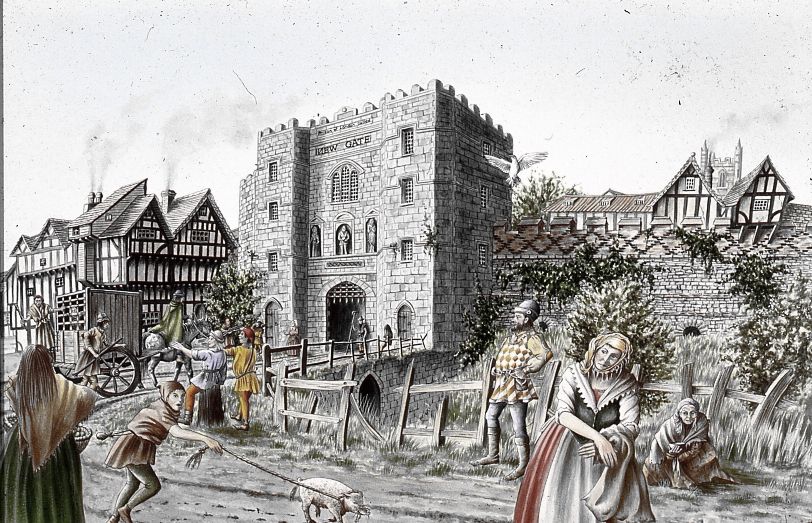Here are listed the public guided walks and tours I have in my diary. I will be adding others all the time.
Tudor London – The City of Wolf Hall 11.30am 13th July 2025 To Book
Jane Austen’s London Anniversary Walk 3pm Sunday 13th July 25 To book
Roman London – Literary & Archaeology Walk 11.30 am Sat 2nd Aug 2025 To Book
Chaucer’s Medieval London Guided Walk 2:30pm Sat 2nd Aug 2025 To Book
Myths, Legends, Archaeology and the Origins of London 11.00am Sat 11th Aug 2025 to Book
The Archaeology of London Walk 6.30pm Fri 3rd October 2025 To Book
Chaucer’s Medieval London Guided Walk 11:30pm Sat 4th Oct 2025 Aldgate Underground To book
Jane Austen’s London Anniversary Walk 2.30pm Sat 4th Oct 25 To book
The Decline And Fall Of Roman London Walk 11.30pm Sat 8th Nov 25 Exit 2 St Pauls Underground Station To book
The Rebirth Of Saxon London Archaeology Walk 11.30am Sun 23rd Nov 2025 To Book
Charles I and the Civil War. Martyrdom Anniversary Walk Jan 30th 2026 To book
For a complete list of my guided walks for London Walks in 2025 look here
Festival of St John the Baptist June 24th
Two of the biggest feast days in London were held in late June. The Feast Days of St John the Baptist (June 24th) and of St Peter and Paul (29th June) were remarkable in the scale and the expense of the celebrations.
Here is what John Stow tells us about the processions on the night before the feast of St John (24th June) and St Peter and Paul (29th June):
On the vigil of St. John the Baptist, and on St. Peter and Paul the Apostles, every man’s door being shadowed with green birch, long fennel, St. John’s wort, orpin, white lilies, and such like, garnished upon with garlands of beautiful flowers, had also lamps of glass, with oil burning in them all the night; some hung out branches of iron curiously wrought, containing hundreds of lamps alight at once, which made a goodly show, namely in New Fish street, Thames street, etc.
Then had ye besides the standing watches all in bright harness, in every ward and street of this city and suburbs, a marching watch, that passed through the principal streets thereof, to wit, from the little conduit by Paule’s gate to West Cheape, by the stocks through Cornhill, by Leaden hall to Aldgate, then back down Fenchurch street, by Grasse church, about Grasse church conduit, and up Grasse church street into Cornhill, and through it into West Cheape again.
(Grasse Church Street is Gracechurch Street.)
The whole way for this marching watch extendeth to three thousand two hundred tailor’s yards of assize; for the furniture whereof with lights, there were appointed seven hundred cressets, five hundred of them being found by the companies, the other two hundred by the chamber of London.
(Note a cresset is: a ‘metal container of oil, grease, wood, or coal set alight for illumination and typically mounted on a pole’ (Wikipedia).)
Besides the which lights every constable in London, in number more than two hundred and forty, had his cresset: the charge of every cresset was in light two shillings and four pence, and every cresset had two men, one to bear or hold it, another to bear a bag with light, and to serve it, so that the poor men pertaining to the cressets, taking wages, besides that every one had a straw hat, with a badge painted, and his breakfast in the mornings amounted in number to almost two thousand.
The marching watch contained in number about two thousand men, part of them being old soldiers of skill, to be captains, lieutenants, serjeants, corporals, etc., wiflers, drummers, and fifes, standard and ensign bearers, sword players, trumpeters on horseback, demilances on great horses, gunners with hand guns, or half hakes, archers in coats of white fustian, signed on the breast and back with the arms of the city, their bows bent in their hands, with sheaves of arrows by their sides, pike-men in bright corslets, burganets, etc., halberds, the like bill-men in almaine rivets, and apernes of mail in great number;
There were also divers pageants, morris dancers, constables, the one-half, which was one hundred and twenty, on St. John’s eve, the other half on St. Peter’s eve, in bright harness, some overgilt, and every one a jornet of scarlet thereupon, and a chain of gold, his henchman following him, his minstrels before him, and his cresset light passing by him, the waits of the city, the mayor’s officers for his guard before him, all in a livery of worsted, or say jackets party-coloured, the mayor himself well mounted on horseback, the swordbearer before him in fair armour well mounted also, the mayor’s footmen, and the like torch bearers about him, henchmen twain upon great stirring horses, following him.
The sheriffs’ watches came one after the other in like order, but not so large in number as the mayor’s; for where the mayor had besides his giant three pageants, each of the sheriffs had besides their giants but two pageants, each their morris dance, and one henchman, their officers in jackets of worsted or say, party-coloured, differing from the mayor’s, and each from other, but having harnessed men a great many, etc
John Stow, author of the ‘Survey of London‘ first published in 1598. Available at the wonderful Project Gutenberg: ‘https://www.gutenberg.org/files/42959/42959-h/42959-h.htm’
Pagan Rituals
There are also pagan rituals associated with the Feast of St John. Here is an example of French pagan solstice fires:
“They were lit at the crossroads in the fields to prevent witches and sorceresses from passing through during the night; herbs gathered on Saint John’s Day were sometimes burned to ward off lightning, thunder and storms, and it was thought that these fumigations would ward off demons and tumults.”
For more information, have a look at ‘French Moments’ here:
Summer Solstice?
The Feast of St John is often described as being on the Summer Solstice, it isn’t by modern reckoning, but nor is December 25th the Winter Solstice. But they were celebrated as such by Christians, and the Solstice can be thought of as spread over 3 or 4 days (or more if taking into account Solstice Old style). The major events of the sun and the moon were linked into Christian theology and symbolism. Jesus, son of God, would clearly have arrived at the auspicious time of the Winter Solstice. His cousin, John the Baptist, came to tell the world about the coming of Jesus and so his birthday was exactly 6 months before the Winter Solstice.
St John is also special as most Saint’s Days are linked to the day of their death, but June 24th is the birthday of St John. His beheading by Herod is commemorated on 29th August.
St John Walbrook
St John the Baptist upon Walbrook in the City of London is first mentioned in the 12th Century, burnt down and not rebuilt after the Great Fire of London. The parish was, later, united with St Antholin, Budge Row, The Graveyard survived until 1884 when the District Line destroyed most of the Graveyard and the bones were reinterred below a monument, which can still be seen in Cloak Lane.
A Day Off for Anglo Saxon Freemen
In the Laws of King Alfred the Great, this day was a day off for freemen. I will be writing about Days off in the Anglo Saxon Calender on August 15th.
First published June 2023 republished in 2024, and reorganised in 2025
Brexit Day & Sins of a Tour Guide June 23rd

Today, is Brexit Day, the 9th Anniversary of that terrible day when the Brexit Referendum was lost. Brexit was a terrible term but sadly stronger than the very weak, ‘remain’. Ok you might say to your partner ‘Let’s give it another go.’ ‘Are you committed to the relationship?’ they ask. You say. ‘Yes, I am prepared to remain’. ‘All you can say is you want to remain!? Huh! Where’s the passion?’. But then the devil always had the best tunes.
Here is a survey of opinions about Brexit. To sum it up, we regret it, although we think now is not the time to reopen the wounds. But it is the time to rebuild relationships with Europe. In 10 years or so people believe we should rejoin.
We agree it was a disaster, and we blame the Conservatives and Boris Johnson most strongly, but also Teresa May. Rishi Sunak and Nigel Farage.
I posted on the other anniversary Brexit Anniversary in January here. Please be aware it features swear words, Boris Johnson and Farage.
Sins of a Tour Guide
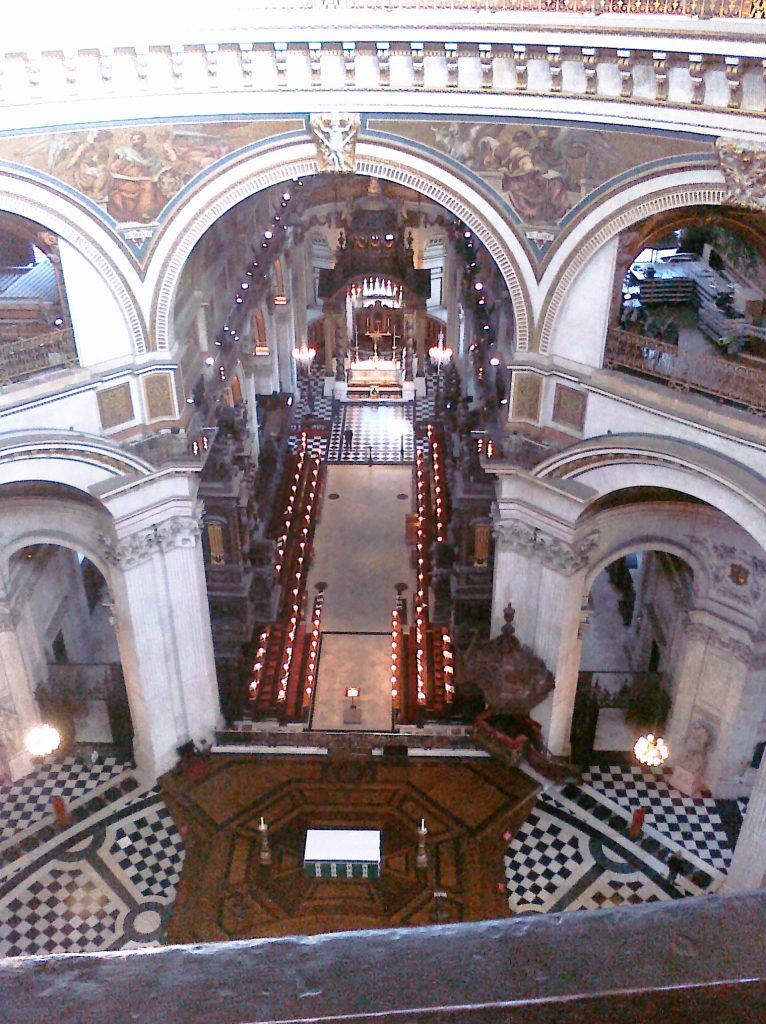
I was in St Pauls yesterday (I wrote this on 23rd June 2022) on an exploration of London’s History. My group had headsets so they can hear me talking into my mic without disturbing others. We went in, sat down in the nave to find an orchestra set up in the crossing. They were rehearsing with a grey haired man, informally dressed, at the podium. I hate talking through music, so wondered whether I would continue.
I began my introduction to St Pauls with a piece about Londinium and Christianity. A tremendous universe – shattering cord erupted from the Orchestra , deafening me. Then a pause, so I continued. I ascertained that my group could hear me, and I continued. I paused during crescendos and to some extent improvised what I was saying to the amazing drama of the atonal music. It was quite an experience and the music was amazing.
This morning I had a chance to check it out and it turns out that I spoke through rehearsals of Olivier Messiaen’s Et Exspecto Resurrectionem Mortuorum. (https://www.youtube.com/watch?v=AU7gVYM5bVE)
And the grey-haired man was none other than Sir Simon Rattle conducting the LSO.
I think I have the right piece of music.
I’m slightly shamefaced about it but on the other hand the group really enjoyed both the music and the explanation.
First written in 2022 and revised in 2025
Midsummer June 21st

Midsummer Solstice is the 21st of June. The Celtic version begins when the Celtic Day begins. This is at dusk on June 20th, which we would call Midsummer’s Eve.
Midsummer is a fire festival, dedicated to the Celtic Fire God, Belinus. His name might mean Powerful One or Shining One, and he is linked to Apollo, one of the Greco-Roman Sun Gods. His main festival is Beltane, May Day, but many of the attributes of May celebrations and indeed Halloween celebrations are also carried out at Midsummer. (See my post on May Day)
In the early medieval period, the Church hijacked Midsummer’s Day and transferred it to June 24th. St John the Baptist’s Day. John was born 6 months before Jesus. John Aubrey in the 17th Century writes:
‘Still in many places on St John’s Night they make Fires on the Hills: but the Civil Warres coming on have putt all these Rites or customes quite out of fashion.’
John Aubrey, Miscellanies, 1695
For my post on St John the Baptist’s Day read my post here.
Like May Fires, the fire should be made from wood donated from all farms in the area, and using a range of trees. Ideally, collected by 9 men and from 9 different trees. Blazing branches should be carried sunwise around the fields to bless the crops, and it was good luck to jump over the ashes of the fire.
To prepare for Midsummer, remember that it is, like Halloween, an uncanny period. Hobgoblins, Fairies and Sprites, are, as in Shakespeare’s Play, Midsummer’s Night’s Dream, all abroad making mischief.
St John’s Wort
First in the line of defence against the infernal is St John’s Wort, known as Chasse-diable, Demon Chaser, Fuga Daemonum (amongst many other appellations). It was used to keep demons away, and to exorcise haunted houses. John Aubrey in ‘Miscellanies’ talks about a haunted London house which was cured by a Doctor who put St John’s Wort under the pillow of the bed. Bankes Herbel 1525 says:

‘The virtue of St John’s Wort is thus. If it be put in a man’s house, there shall come no wicked sprite therein.’
Vervain, yarrow, corn marigold, and orpins were also used, often woven into garlands, and hung around the necks of cows, or on door lintels as protection. If the St John’s Wort withered, the picker was to die or at least endure disappointment. If orpins entwined themselves on Midsummer’s Night, marriage would follow. Orpine, (Sedum Telephium) aka Live Long, or Life Everlasting was valued for the length of time it remained fresh after being gathered. Medicinally, it was considered good to use outwardly to cool scaldings, inflammations, and wounds.
St John’s Wort has a reputation for helping with depression, menopausal symptoms, ADHD, anxiety and other conditions.

Hempseed & Love & Churches
A girl seeking love should walk around the Church seven or twelve times (accounts vary!) at midnight scattering hempseed, and singing:
Hempseed I sow
Hempseed I hoe
Let him that is my true love
Come after me and mowIn the South West of England, there was a custom to watch the church porch on Midsummer Evening. This was when the spirits of all the living people of the village could be seen entering the church. Those not seen coming out again would surely die, as would any watcher foolish enough to fall asleep.
Thanks to the ‘Customs and Ceremonies of Britain’ by Charles Kightly.
First written in June 2023, and revised and republished in June 2024, and 2025
Moneywort June 20th

Moneywort
Moneywort flowers in June/July. It is, also known as Creeping Jenny, Wandering Jenny, Creeping Joan, or Wandering Sailor. All names alluding to its rapid trailing over the ground.
It’s also called Herb Tuppence or String of Sovereigns and variations. ‘Herbe 2 pence’ was the name given by William Turner in the earliest English scientific Herbal, 1551. Turner was very controversial because the apothecaries and physicians did not want ordinary people to know the virtues of plants. Or why else would anyone employ them? So restrictive practices was the name of the game for trained medical men. So Turner, by publishing these volumes, was doing something good for the public, and bad for his fellow professionals.
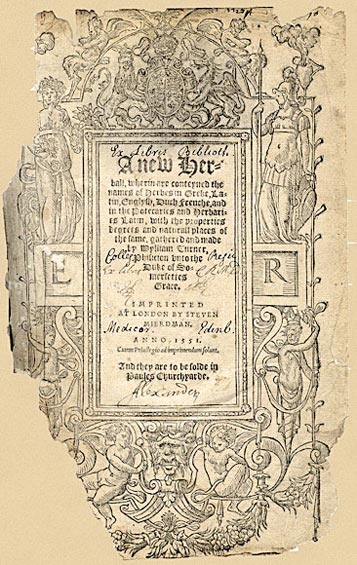
Its Latin name is Lysimachia nummularis (from the Latin for money nummulus). Mrs Grieve suggests that the two pence idea comes from the leaves which ‘look like rows of pennies, and the golden flowers which give the name String of Sovereigns.’
There was said to be ‘not a better wound-herb’, and that wounded serpents would wrap themselves around it. Hence, yet another name is Serpentaria. Also, it was thought to be good for stomachs, and against whooping cough.
It can be used both fresh or dried, but if to be dried, collect in June. It prospers in damp conditions and self-spreads.
William Turner & Ferrara
I have just come back from Ferrara. While there, we were given a tour of the Palazzo Paradiso and nearby buildings. These are town houses originally built for the Estes, the Dukes of Ferrara, in the 14th Century. In 1567, the Palazzo Paradiso was rented out to the University of Ferrara. Turner learnt his medicine in Italy in Ferrara and Bologna between 1540 and 1542. He was awarded his M.D. while in Italy. But, I’m not sure where the medical facility was in 1540. But I am not going to miss this opportunity to show some lovely medieval architecture, that Turner might well have seen. And an early modern Anatomy Theatre.

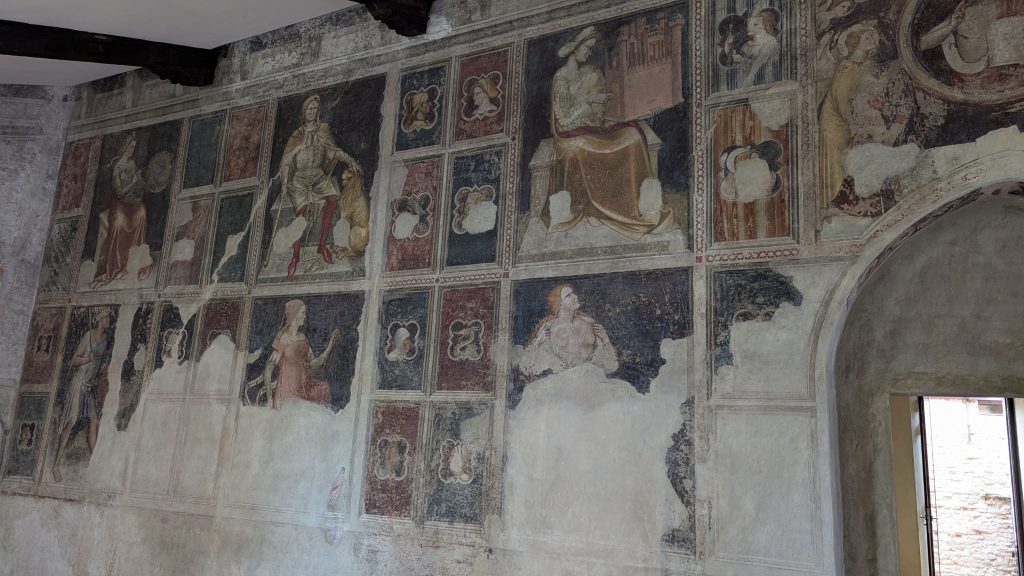
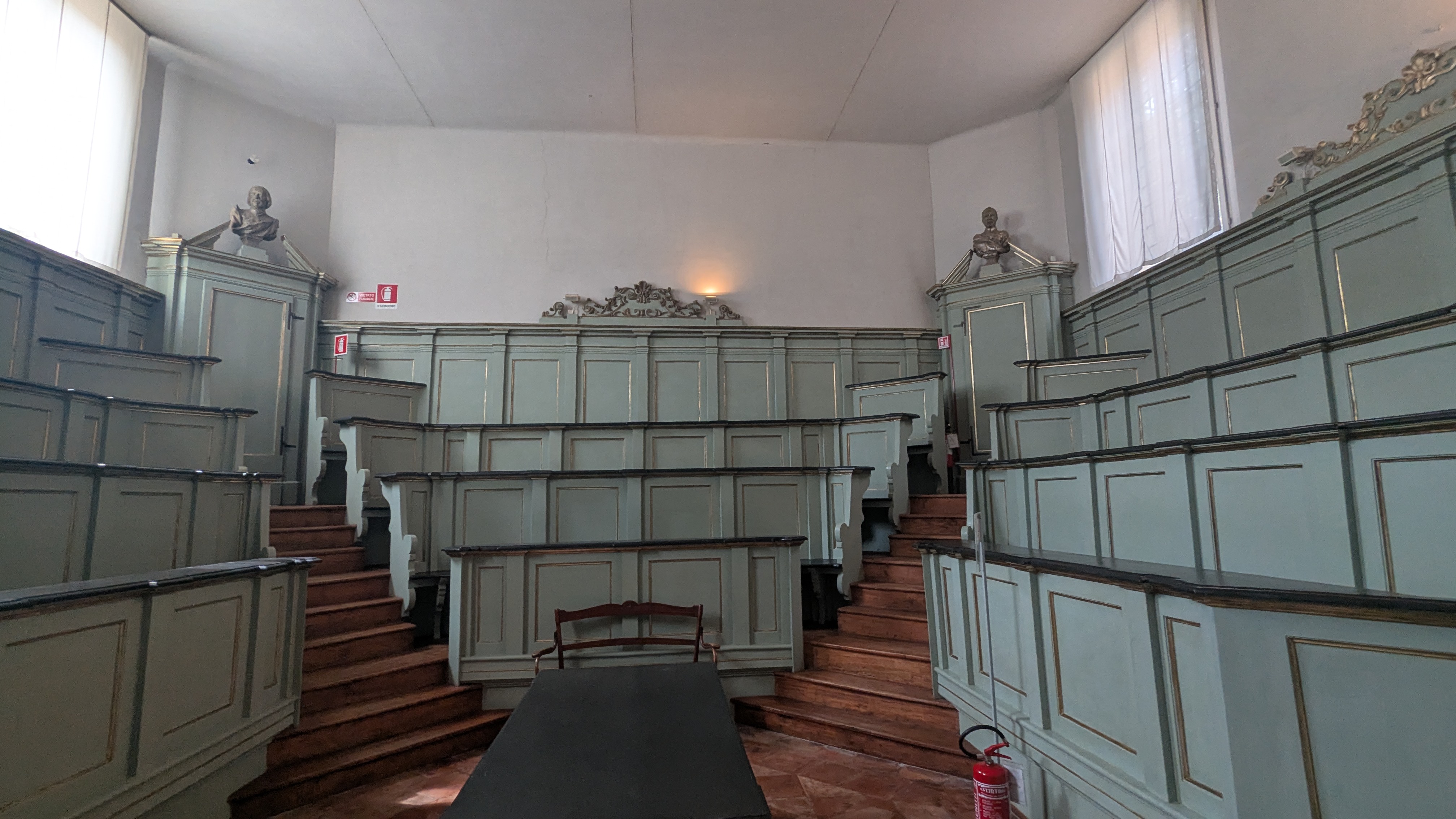
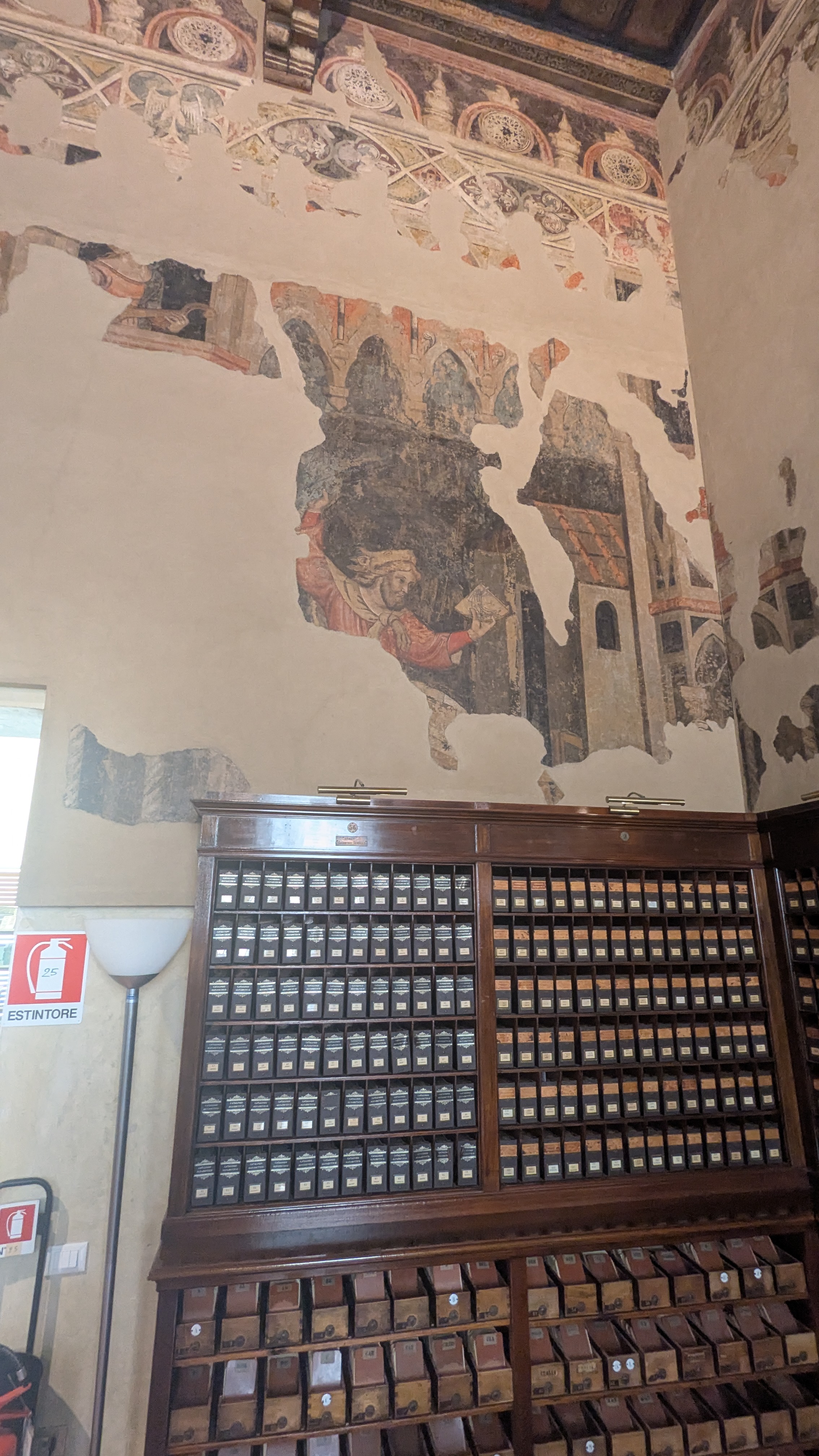
In the Tower of the building are kept the remains of Ludovico Ariosto, the great medieval Italian poet (1474 – 1533). He wrote the epic Orlando Furioso (1516).
Weather in June
Calm weather in June
Sets corn in tune.
When it is hottest in June, it will be coldest in the corresponding days in February.
(Weather Lore by Richard Inwards 1895)
To read my post on Coltsfoot and Smoking read my post here.
For more on Ferrara read my post on the Pallio.
First written in June 2023 and republished in 2024, and 2025
Death of Luca Pacioli the Father of Double Entry Bookkeeping June 19th 1517
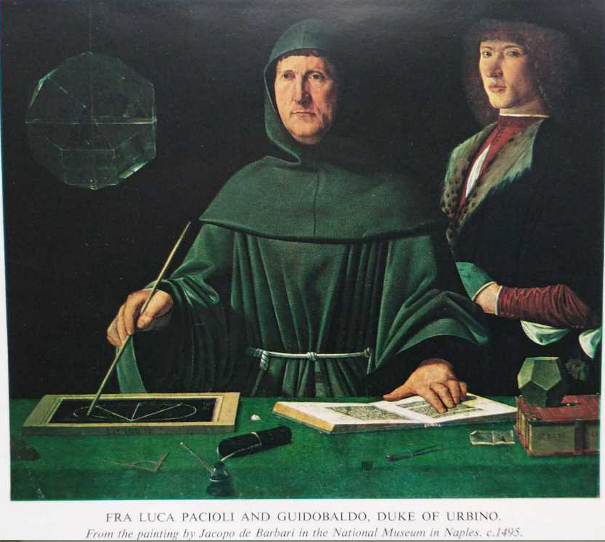
Luca Pacioli was a mathematician, whose mathematical text book had a section on Venetian book-keeping. It was published in 1494 although double entry booking keeping was probably being used earlier. The accountancy is a 27-page section called “Particularis de computis et scriptus. It is part of the compendious ‘Summa de Arithmetica, Geometrica, Portiona et Proportionali’.
It is the source of modern double entry accounting, which spread from Venice as it was the printing capital of Southern Europe.
The key discovery, reported by Luca Pacioli, was that every transaction had to have an entry in both a debit and credit account. So if I lend you £10,000 then my account is debited by 10k and yours is credited by the same amount. Fra Luca (he was a Franciscan Friar) would have it that the accountant could not go to bed until the ledgers balanced. That is, that all the credits and balances in all the ledgers balance.
Double entry bookkeeping has prevented numberless frauds, kept many businesses on the straight and narrow. But it is of course not proof against sophisticated fraud.
Assyrian Double Entry booking keeping?
The gypsum stone reliefs shown below on display in the British Museum show clerks recording booty plundered in the Assyrians’ wars. The soldiers are bringing goods in to be counted. In the first picture, the goods are severed skulls. In the second are a wide range of booty.
In every scene like this, there are two scribes writing notes on clay tablets with styli. They stand side by side. I presume their role is to make sure the other man doesn’t cheat, rather than to facilitate double entry book keeping as such. Assyrians paid their soldiers for each enemy soldier they killed, and the head was the proof. You will see a little pile of severed heads between the soldier and the scribes.

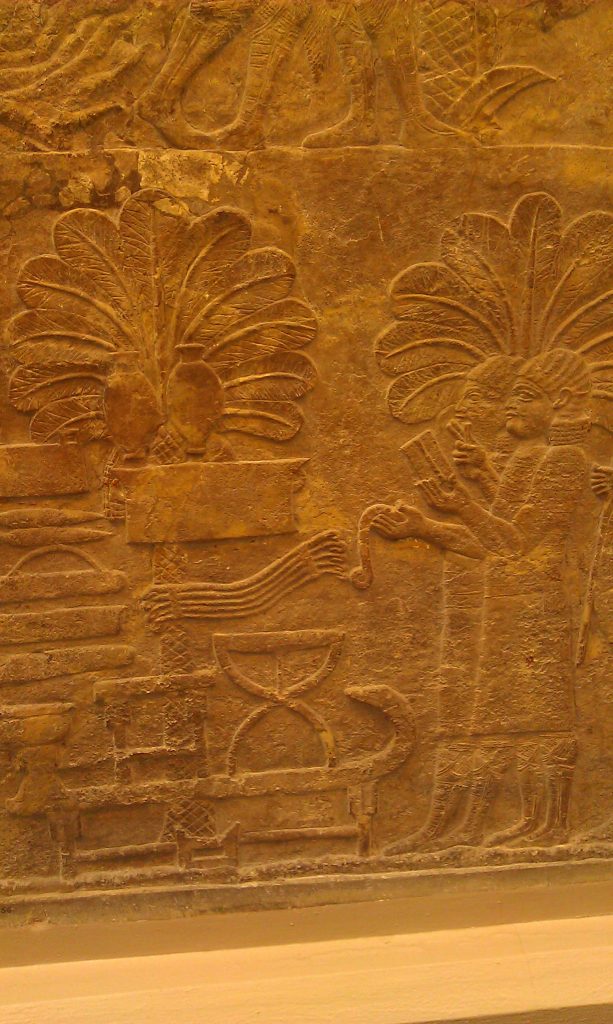
Italians, Accountancy and London.
The earliest work on double entry in England was by Oldcastle in 1543. There were a lot of Italian businessmen in Tudor London. Thomas Cromwell was friends, and indeed neighbours, with some. As a young man he was helped out by the head of one of the great Florentine Finance houses, Frescobaldi. They had branches in Bruges and London, and were major financiers to the Kings of England. Thomas More lived among the colony of Merchants from Lucca. The business centre of London before the building of the Royal Exchange was in Lombard St, where the Lombardian bankers hung out.
More on the British Museum in my post here
First Published on June 19th 2025
The Great Broadway Paint off
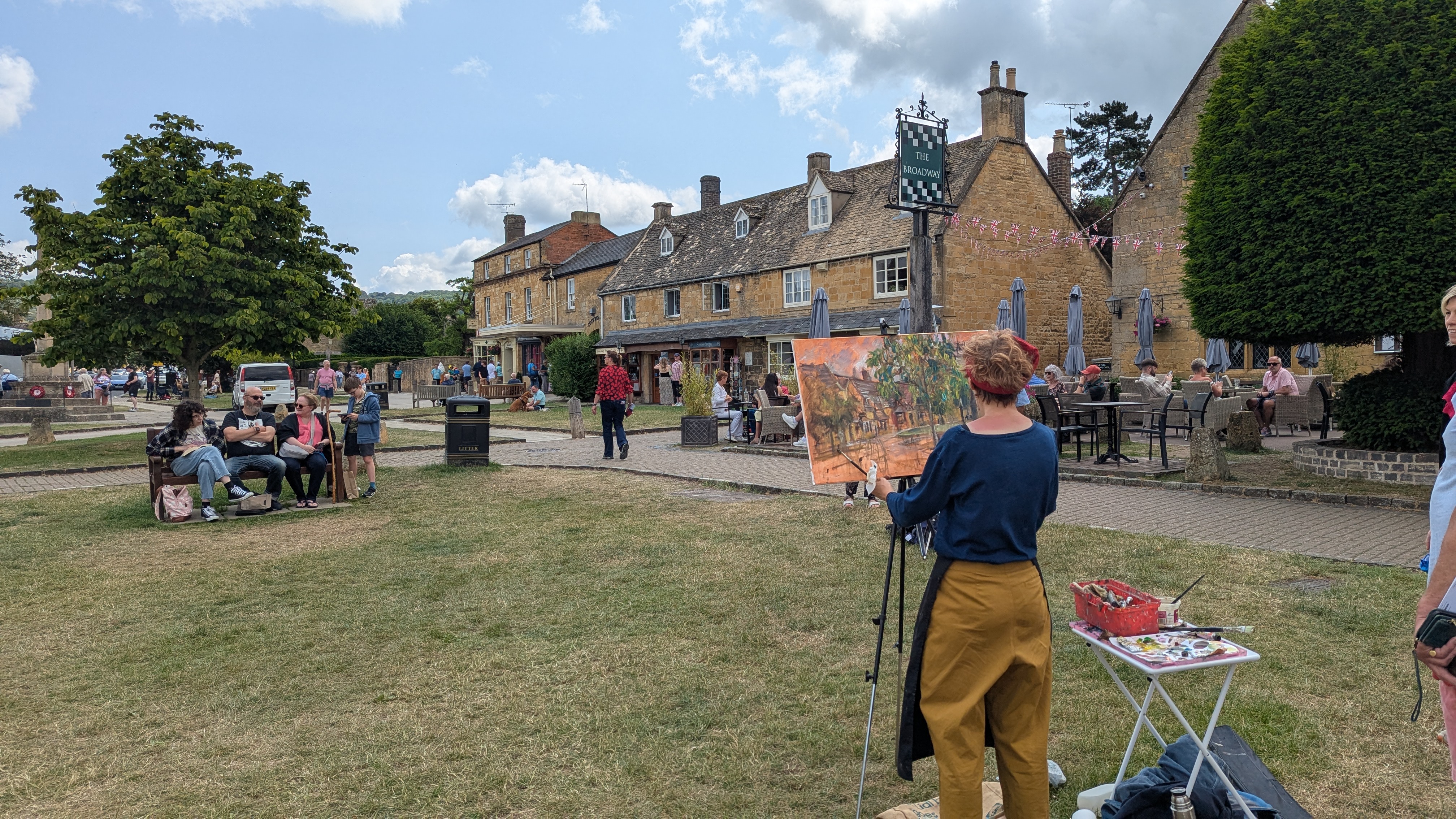
One of the joys of my Summer is revisiting places I know and love in my role as a Course Director for Road Scholar. I first came across the ‘en plein air’ in 2023. On Sunday, June 18th. I was in Broadway, once considered the most beautiful village in Britain. It was also the model for Riseholme in the wonderful Lucia books by E. F. Benson (made into a TV series by the BBC starring Prunella Scales, Geraldine McEwan and Nigel Hawthorne).
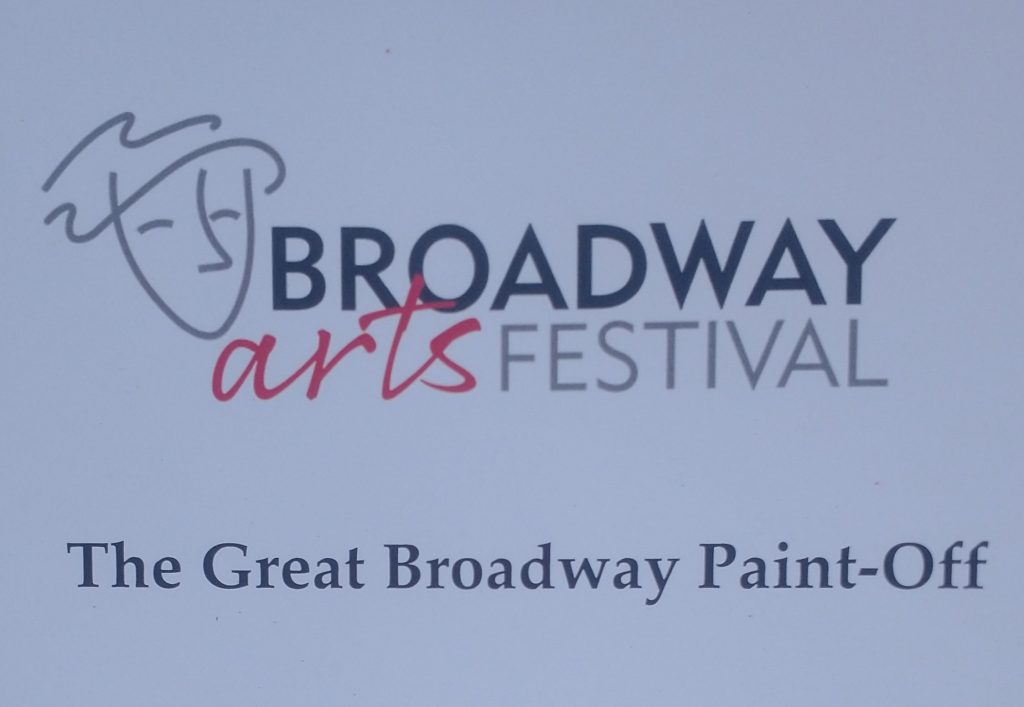
The day I visited, in 2025, was last Sunday, June 15th. I have added new photos and revised the texts.
How it Works
The artists register in the morning and have their paper or canvas stamped, or given a block of Maltese stone. This proves that they have done all the work on the day itself.
This year there were no sculptors. Instead, there were live models in the marquee being painted by portrait painters.
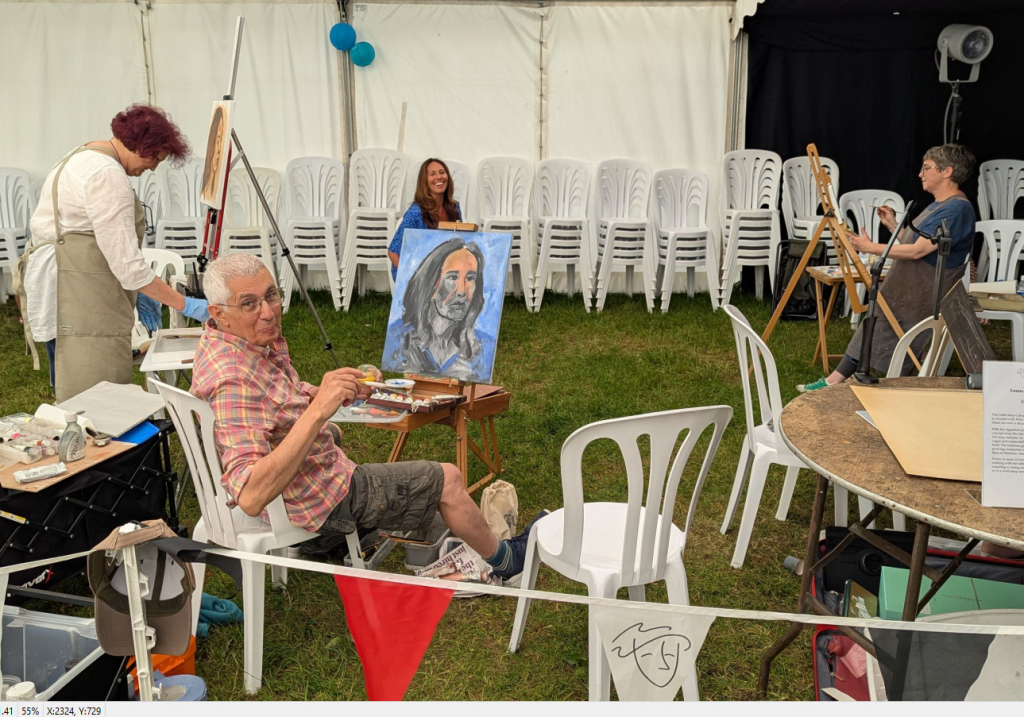
They take their blank canvases to create a work of art in the village. At 4pm or so, they are judged. At 5pm, the art works are exhibited and are on sale in the Marquee on the village green.
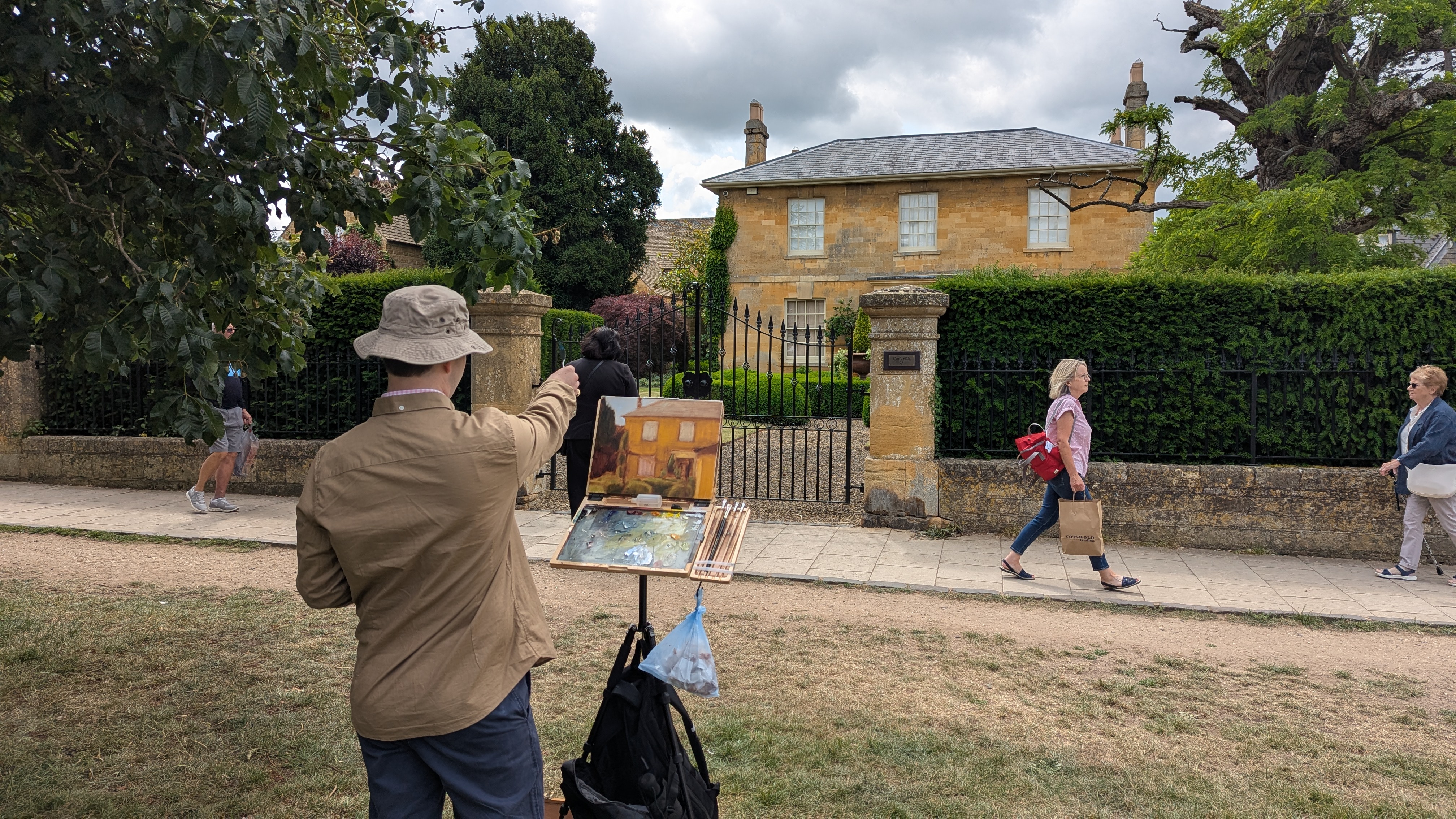
It’s always a delight walking around Broadway. Bun, but with an artist and easel every 50 yards or so even more enjoyable.
The Most Beautiful Village?
The appellation of most beautiful village, came in the late 19th Century. Broadway, once gained its wealth by selling wool. When that declined, the village became an important stop on the Toll Roads. It was on the stage coach route from Aberystwyth to Worcester, Oxford, and London. Fish Hill, nearly 1000 feet high, was an obstacle and coaches made a stop here to prepare or recover. Some coaches used up to 10 horses to get to the top. But with the arrival of Brunel’s Great Western Railway to the Cotswolds the village was nearly ruined. Half the village, the Broadway Museum says, moved away as their livelihood serving the coaching trade died.
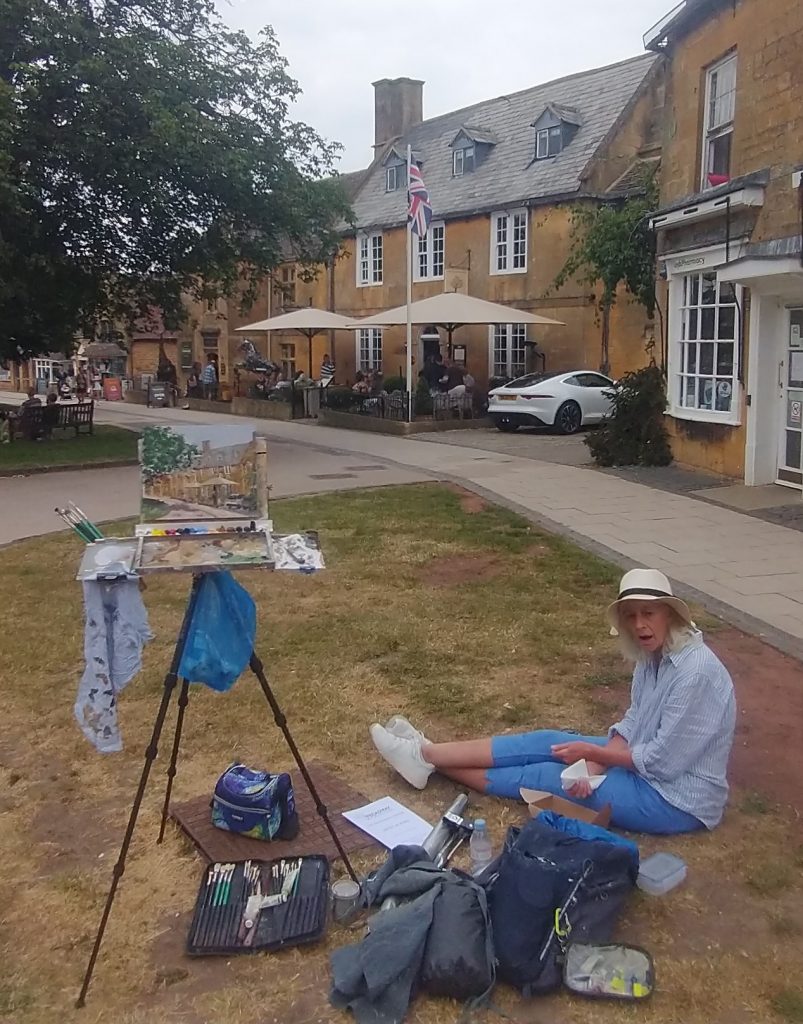
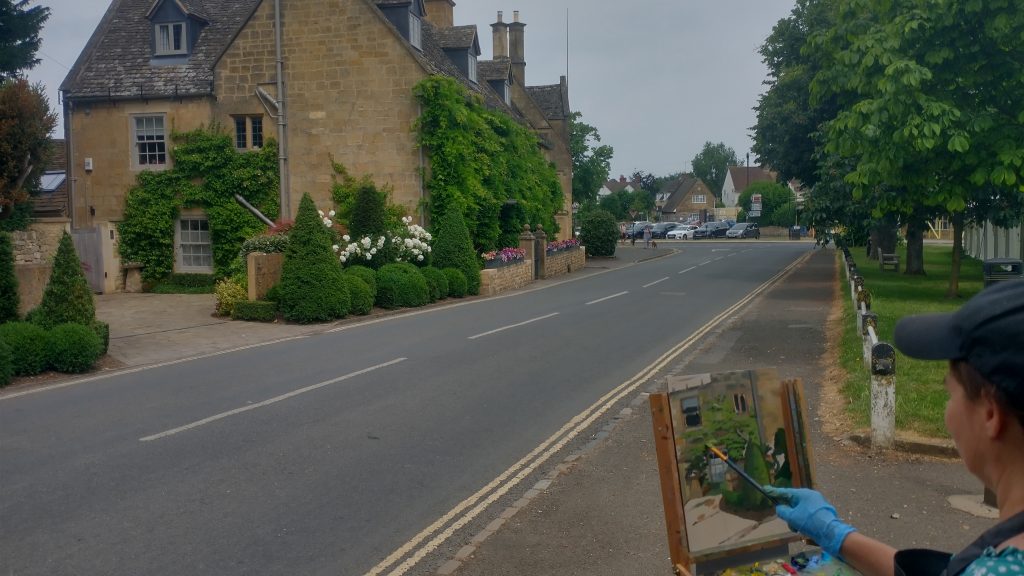
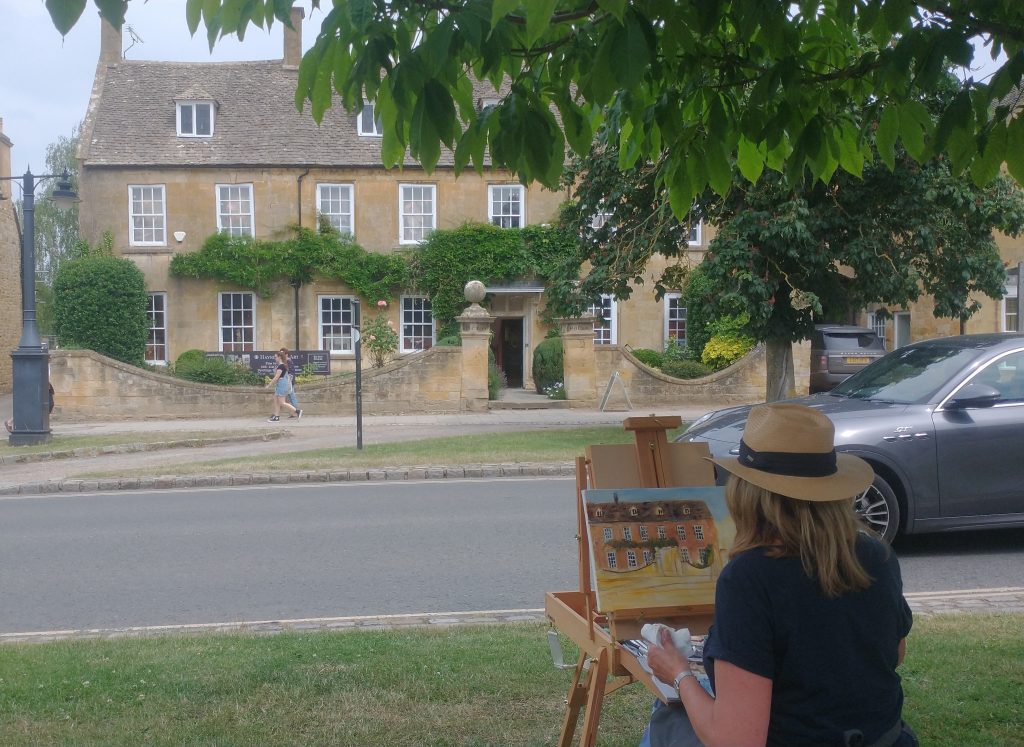
But artists and writers, led by Americans Frances Millet and Edwin Abbey, turned Broadway into a much sort-after country retreat. Visitors included Oscar Wilde, J. M. Barrie, Singer-Sargeant, William Morris, Edward Burne-Jones, Gabriel Dante Rossetti, American actress, Mary Anderson, Edward Elgar, E. F, Benson. Mark Twain visited for Millet’s marriage.
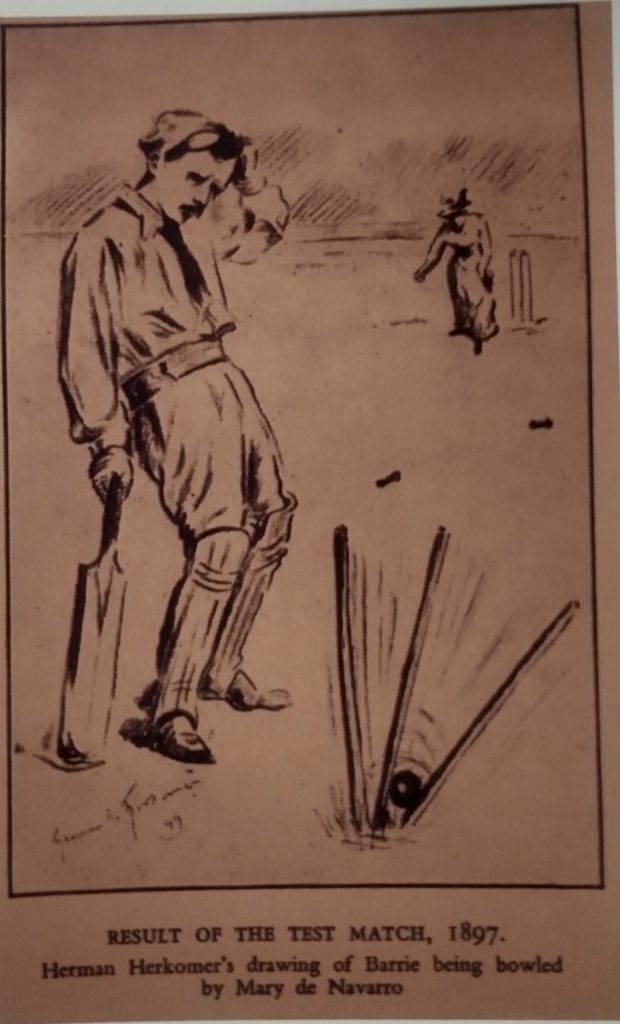
Gordon Russell & Henry T Ford
What made the visit particularly interesting was the story told by the volunteer at the Gordon Russell Museum in Broadway. This is the story as I understood it:
The Russells restored the Lygon Arms in Broadway using Arts And Crafts architects. They also restored antique furniture. The son, Gordon Russell, became a leading designer of modernist Furniture. He advertised to passengers on the Cunard Line in order to attract the attention of rich American visitors. One, Henry T Ford, was interested. He came to Broadway, staying at the Lygon arms. He was taken to nearby village Snowshill, where Ford bought a Cotswolds Farmhouse, complete with Blacksmith’s workshop. They were shipped stone by numbered stone to Brentford on the Thames. Then to the London Docks and across the Atlantic. Here. Ford set them up in a Museum in Michigan where they still are!
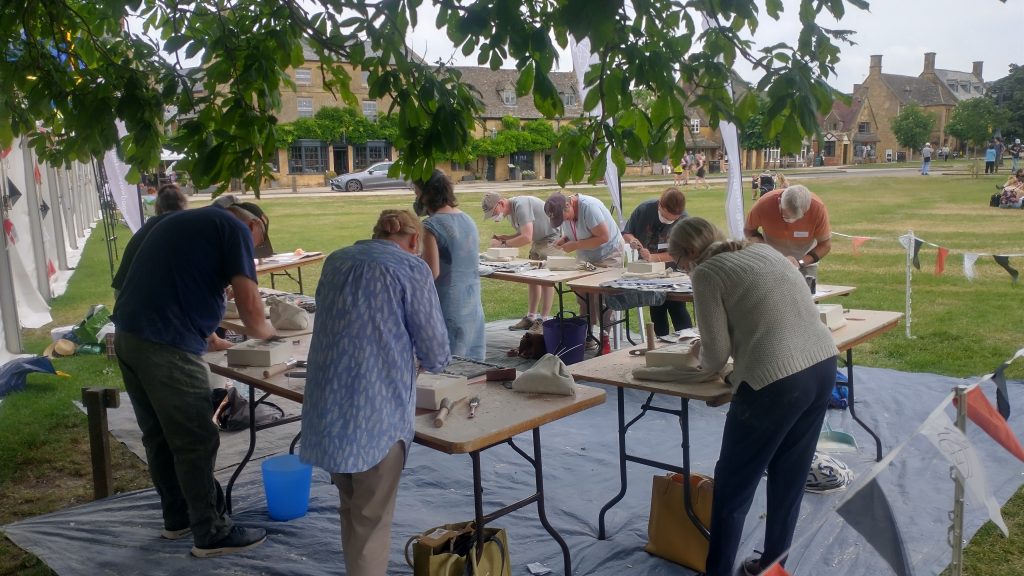
Research suggests it’s a little more complicated, in so far as Ford purchased his first Cottage before coming to Broadway. But it still leaves a delightful story about American ideas of Quintessential English village life. For pictures see my post here. And for another look at the story look at this web site here:
By the way, Frances Millet planned to return to the States on the Titanic. He was one of the 1500 who drowned. A letter he wrote while on the ship was posted, probably in France. It is on display in the Broadway Museum (2023).

For more about Broadway, Gordon Russell and Word War 2 see my post here:
June 18th is also:
National Chocolate Ice Cream Day
First Published in June 18th 2023, Republished in June 2024, and revised in 2025
Molly Bloomsday June 16th

Molly Bloomsday & the Stream of Consciousness.
Molly Bloomsday is a new festival, an offshoot in Derry of the Dublin based Bloomsday. Both are celebrated on 16th June which is the day on which the great book Ulysses by James Joyce is set (16 June 1904). It was published in 1922.
Bloomsday is named after Leopold Bloom and is an international festival celebrating Ulysses. Molly Bloom is her husband who has a soliloquy at the beginning of the book. The Molly Bloomsday concentrates on Molly and women’s literature. The Dublin version is a literary festival as well with people dressing up as characters from the famous book, readings, plays etc..
The Bloomsday Book
Joyce thought Odysseus was the only all-round character in literature. Not a one dimensional hero, but a man with a complex character, not always making the good choice. He based Ulysses, loosely, on Homer’s plot. The main characters, Leopold and Molly Bloom were based on Odysseus and Penelope. Stephen Daedalus was Telemachus, their son. Daedalus is Joyce’s alter-ego.
What makes the book so great is that Joyce was, with Virginia Wolfe, one of the first great Modernist writers. They used stream of consciousness from the characters’ points of view from deep in their heads. This is how Joyce describes Ulysses according to Djuna Barnes:
“The pity is … the public will demand and find a moral in my book—or worse they may take it in some more serious way, and on the honour of a gentleman, there is not one single serious line in it. … In Ulysses I have recorded, simultaneously, what a man says, sees, thinks, and what such seeing, thinking, saying does, to what you Freudians call the subconscious.”
Ulysses and I
My copy of Ulysses is very well travelled. I very often take it on holiday. I start on Chapter 1, and at some point before the end of the holiday I am still on Chapter. I stop reading. I’ve got past the beginning of Chapter 2 once.
Don’t get me wrong, I am fully convinced it is a brilliant book. It’s my best friend’s favourite book. So one day I WILL READ IT!
Modernism & the Steam of consciousness
When I first published this piece I made a terrible typo and talked about the ‘steam of consciousness’. So I republished it immediately so not to embarass myself for too long. But, actually, I quite like the sound of a steam of consciousness. But what could it mean?
For a touch more modernism, see my post: boating-adventure-the-second-best-modernist-building-in-london/
First published on June 16th 2025
Smithfield & the Peasants’ Revolt June 15th 1381
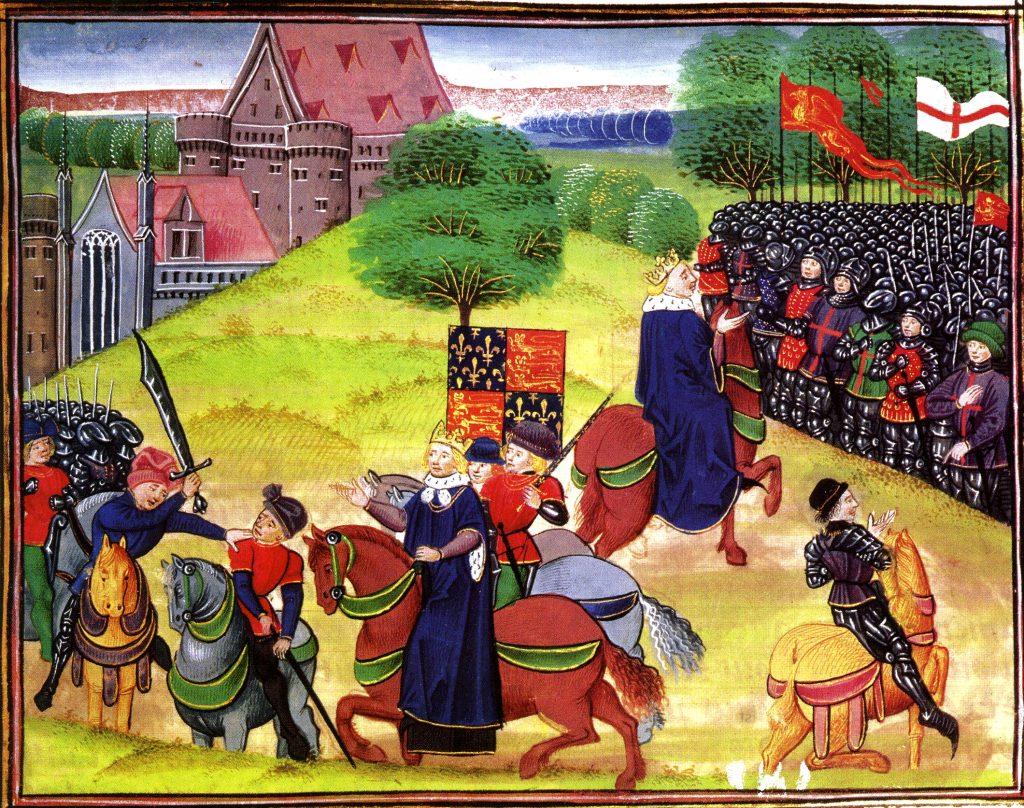
On the 15th June, King Richard went to pray at Westminster Abbey before the climax of Smithfield & the Peasants’ Revolt. He prayed at the shrine of St Edward the Confessor. A King who knew all about the sins Kings are forced to commit to rule an unruly Kingdom and could intercede on the King’s behalf in Heaven
The Peasants’ met at Smithfield, or maybe they had camped out there overnight. It was a big field where the livestock market was held. And where people were executed. Most famously Scottish patriot, William Wallace, who was hanged, drawn and quartered here on 23 August 1305. It was also used for jousting, and one of the streets off Smithfield is called GiltSpur Street.
The King, Smithfield and the Peasants’ Revolt
The King had agreed to meet the Peasants again. We don’t know how that was organised. The King turned up supported by a group of men who included members of the City of London Corporation including the Lord Mayor, Fishmonger, William Walworth. They seem to have worn armour under their clothes. The King’s Party lined up in front of St Bartholomew’s the Great Priory.
The rebels were on the other side of the field, presumably armed with the weapons and armour they had plundered from the Tower of London. It is not clear exactly what happened, and the sources are prejudiced against the rebels.
The Rebels demands were: the abolition of all Lords except the King; all bishops except the Archbishop; all monasteries except the Friaries and the replacement of the false House of Commons, with the True House of Commons.
Wat Tyler rode towards the King’s party. Got off his pony, spat out the wine he had been drinking, and ‘Hailed, Brother’ slapping the King on the shoulder. This was not normal court etiquette.
One of the King’s party shouted at Tyler that he was a thief and a murderer. Tyler drew his sword, and William Walworth struck him down, mortally wounding him.
Commentators speculate that this might have been part of a plan. To arrive seemingly without armour, to provoke a crisis, and disrupt the rebels.
The City’s part in the events in Smithfield is fascinating. City Merchants were not generally fighting men, but they seem to be the active group the King could rely on. Interestingly, there is no evidence that the Rebels attacked the Guildhall and destroyed the legal records. They attacked most important legal institutions in London, in the days before Smithfield. So why no attack on the Guildhall?
This surely must be because the Guildhall was protected by a competent military force. And it seems these are the same people who took on and defeated Wat Tyler.
In Smithfield, the Rebels didn’t know what to do. Is it possible the King’s party shielded the murder of Tyler behind a screen of people? So they didn’t know what happened and therefore didn’t know what to do?
For surely this was a moment of true danger. The Rebels would have had hundreds if not thousands in Smithfield, some at least well armed. Some must have been archers who would have been deadly. This is not that long after the Battles of Crecy and Poitiers, where the flower of the French Nobility was killed by the English Archers. Archers were normally rank and file soldiers, exactly the class of people supporting the Rebellion. Tyler was taken to St Bartholomew’s Hospital, where he died of his wounds.
In the moment of crisis, the King is said to have ridden forward on his horse and told the Rebels:
‘I will be your leader.’
And then he led them, like the Pied Piper of Hamlin, to their destruction.
He led them out of Smithfield into the field surrounding and told them they had their Charters so it was time to go home. And mostly they did.
To be continued.
To read my post mile-end-the-peasants-revolt-june-14th-1381/
Also on this day June 15th Magna Carta was signed in 1215
First Published on 15th June 2025
Mile End & the Peasants’ Revolt, June 14th 1381

To recap. On June 14th the 1381 Rebels have control of London. They are destroying any repository of legal records they can find. People are walking the streets dispensing street justice. Foreigners who speak Flemish are being beheaded. Enemies of the people are being dragged out of sanctuary and beheaded. Properties of the leaders of the government are being ransacked and burnt.
The King is in the Tower with his advisors, fearful that the Rebels will breach the defences. I would love to be a fly on the wall of that conversation. You would think it would go something like.
‘Sire. Your safety is paramount. We will leave the castle and draw off the rebels so you can go to a place of greater safety.’
What happened is astonishing. The Royal plan was to send the 14-year-old King Richard out to draw off the rebels so that the hated Chancellor of England, Archbishop Sudbury and the Treasurer of England, Robert Hales could slip away unseen! Putting the young boy king in the direct line of fire!
There are two explanations. Hales and Sudbury were arrant cowards. Or the King was very confident of his safety and despite his youth made his advisors accept his command. This was an age where young princes took adult responsibilities early.
The King left the Tower on horse back, accompanied by two half-brothers and his mother (and others). Their reception was hostile. We have eyewitness accounts of angry rebels pulling at the King’s bridle and that of one of his attendants from the City government. The King sent his mum and brothers back to the Tower as it was too dangerous. We can only assume the King sent them back sure that the peasants did not blame him for the mess the country was in.
He went to Mile End. His clerks set up tables and began writing charters freeing the peasants from feudal duties and turning their tenure into monetary rents.
As each village received its charter, many of the villagers went home. Back at home they sometimes attacked the people who had been manipulating the legal system, believing the King had given them permission to punish the guilty.
Whether the king believed in the justness of their claim or was just placating them to gain time, we do not know. But some historians believe that the young King was sympathetic to some of their claims, until older counsel made him change his mind.
Not all the rebels followed the King to Mile End, nor went home when their charters were sealed. It is thought Wat Tyler and thousands of rebels stayed at the Tower.
They saw the Archbishop of Canterbury trying to escape. They forced their way into the Tower. Here they jumped up and down on the Queen Mother’s bed, stole armour and weapons. Then dragged Hales, Sudbury, a Franciscan Friar (William Appleton, John of Gaunt’s physician), and John Legge, a royal sergeant to the scaffold at Tower Hill and beheaded them. Their heads were put on poles and paraded around town.
When the King left Mile End he couldn’t go to the Tower so he went to Baynards Castle, near Blackfriars. We also know that, the King’s cousin, Henry Bolingbroke was in the Tower. He was the son of the hated John of Gaunt. Years later, when he was King, he acknowledged the fact that a Londoner had been instrumental in saving his life in the Tower on the 14th of June, 1381. The man was fighting charges of stealing gold from the ransacking of Gaunt’s Savoy Palace. He was given a pardon.
That night rebels remained in London, and the king’s cause had been considerably weakened.
To be continued. See also my post peasants-revolt-june-13th-1381/
First published in 2025.
.
Peasants’ Revolt June 13th, 1381

The day began with the King and advisors sheltering in the Tower of London, as the rebels approached London. The King took 4 or 5 ships to Greenwich, to attend a parley with the rebels. The men of Kent descended from Blackheath on the South Side and those from Essex came to the River on the North side. The King’s advisors told him it was too dangerous to meet the rebels. So, he retreated to the Tower of London.
The Kentish rebels marched on Soutwark, opening the Marshelsea prison, and targeting properties in Southwark to ransack. They persuaded the Warden of London Bridge to let down the drawbridge and the rebels poured into the City of London. Outside the Aldgate (the home of Geoffrey Chaucer and his wife) rebels from Essex clamoured to be let into the City of London. Allies from inside the Walls, helped persuade the Warden of the Gate, William Tonge, to open it.
The rebels attacked and burnt St Johns of Jerusalem, the Knights’ Hospitalers monastery in Clerkenwell. The prior was Robert Hales, the Treasurer of England and on the list of people the rebels wanted executed for his part in imposing the Poll Tax; and running a system which used the law to keep the working class in subjection. The Fleet and Newgate Prison were attacked and prisoners released.
Prisons were a particular target because following the huge death rate in the Black Death of 1348, workers were legally required to work at pay rates predating the plague. With the shortage of labour, wages had gone up, and the ruling classes were using the legal system to stop workers benefitting from the shortage of labour. Punishment could include branding and imprisonment. This was still continuing 40 years after the Black Death!
Chaucer is an example of how the law was being used oppressively. He was accused of kidnapping a cook, Cecily Chaumpagne, from her rightful employer. It turns out that she was jointly accused with the poet of breaking the Statue of Labourers. So a cook and her new employer could be taken to the law for simply changing jobs. The ‘Peasants’ (who included not only agricultural workers, but also artisans, and even gentlemen) freed prisoners from unfair imprisonment. (see my post on this episode here)
On the 13th, the rebels also attacked the Temple, burning legal records, and attacked the magnificent Savoy Palace. This was the home of the Duke of Lancaster, the formidable John Of Gaunt, the real ruler of the country. Richard II was his nephew, and was 14 at the time. So the rebels did not blame him for the problems of the Government.
The problems included setbacks in the 100 Year War with France, as the gains of Edward III were progressively lost. In order to retrieve the situation, a series of taxes, particularly poll taxes, were levied. The rich paid the same as the poor. But the revolt only broke out when the Government realised that the 1381 tax was not bringing in so much money as the previous taxes. It became clear that a large number of tax payers had disappeared since the last tax. Commissioners were set out into Essex to find the arrears. They were attacked by the people, and the Revolt began.
John of Gaunt was in Scotland, and the King had no body of troops to impose order. in the evening with fires burning all around London, Rebels gathered outside the Tower of London. The King and his advisors were trapped inside. Rochester Castle had previously fallen to the Peasants, and so a plan was made to lure the rebels away, and allow the hated Robert Hales, and the Chancellor of England Archbishop Sudbury of Canterbury to escape.
What would the morning bring?
To be continued.
First published, in haste, on June 13th 2025
